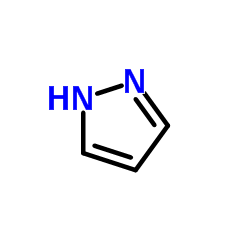Pyrazole

Pyrazole structure
|
Common Name | Pyrazole | ||
|---|---|---|---|---|
| CAS Number | 288-13-1 | Molecular Weight | 68.077 | |
| Density | 1.1±0.1 g/cm3 | Boiling Point | 187.0±9.0 °C at 760 mmHg | |
| Molecular Formula | C3H4N2 | Melting Point | 67-70 °C(lit.) | |
| MSDS | Chinese USA | Flash Point | 87.5±11.7 °C | |
| Symbol |

GHS07 |
Signal Word | Warning | |
|
Apoptotic and neurotoxic actions of 4-para-nonylphenol are accompanied by activation of retinoid X receptor and impairment of classical estrogen receptor signaling
J. Steroid Biochem. Mol. Biol. 144 Pt B , 334-47, (2014) • Age-dependent action of nonylphenol (NP) on mouse neuronal cells was demonstrated. • Estrogen receptor (ER) antagonists potentiated the NP-induced apoptosis and toxicity. • ER agonists inhibited the NP-evoked effects in mouse hippocampal cells. • The retino... |
|
|
Stable and potent analogues derived from the modification of the dicarbonyl moiety of curcumin.
Biochemistry 52(42) , 7449-60, (2013) Curcumin has shown promising therapeutic utilities for many diseases, including cancer; however, its clinical application is severely limited because of its poor stability under physiological conditions. Here we find that curcumin also loses its activity inst... |
|
|
Development of a UHPLC-MS/MS method for the determination of plasma histamine in various mammalian species.
J. Chromatogr. B. Analyt. Technol. Biomed. Life Sci. 971 , 35-42, (2014) Histamine is an important mediator of anaphylactic reactions. Although several methods have been developed to measure histamine levels, each has its limitations. In this study, we developed and validated a convenient bioanalytical method for the qualitative a... |
|
|
Benzyl alcohol attenuates acetaminophen-induced acute liver injury in a Toll-like receptor-4-dependent pattern in mice.
Hepatology 60(3) , 990-1002, (2014) Acetaminophen (APAP) toxicity is the most common cause of acute liver failure in industrialized countries. Understanding the mechanisms of APAP-induced liver injury as well as other forms of sterile liver injury is critical to improve the care of patients. Re... |
|
|
Ethosuximide Reduces Mortality and Seizure Severity in Response to Pentylenetetrazole Treatment During Ethanol Withdrawal.
Alcohol Alcohol. 50 , 501-8, (2015) We recently demonstrated that T-type calcium channels are affected by alcohol abuse and withdrawal. Treatment with ethosuximide, an antiepileptic drug that blocks T-type calcium channels, reduces seizure activity induced by intermittent ethanol exposures and ... |
|
|
Effects of chronic ethanol exposure on neuronal function in the prefrontal cortex and extended amygdala.
Neuropharmacology 99 , 735-49, (2015) Chronic alcohol consumption and withdrawal leads to anxiety, escalated alcohol drinking behavior, and alcohol dependence. Alterations in the function of key structures within the cortico-limbic neural circuit have been implicated in underlying the negative be... |
|
|
Critical period for dopaminergic neuroprotection by hormonal replacement in menopausal rats.
Neurobiol. Aging 36(2) , 1194-208, (2015) The neuroprotective effects of menopausal hormonal therapy in Parkinson's disease have not yet been clarified, and it is not known whether there is a critical period. Estrogen induced significant protection against 6-hydroxydopamine-induced dopaminergic degen... |
|
|
Triazolo and imidazo dihydropyrazolopyrimidine potassium channel antagonists.
Bioorg. Med. Chem. Lett. 23(6) , 1743-7, (2013) Previously disclosed C6 amido and benzimidazole dihydropyrazolopyrimidines were potent and selective blockers of IKur current. Syntheses and SAR for C6 triazolo and imidazo dihydropyrazolopyrimidines series are described. Trifluoromethylcyclohexyl N(1) triazo... |
|
|
Pretreatment with turmeric modulates the inhibitory influence of cisplatin and paclitaxel on CYP2E1 and CYP3A1/2 in isolated rat hepatic microsomes.
Chem. Biol. Interact. 220 , 25-32, (2014) Previous animal studies have shown that turmeric can significantly modulate the activity of several drug metabolizing enzymes, this may dramatically affect the bioavailability of several drugs resulting in over dose or less therapeutic effects. This study was... |
|
|
Inhibition of CYP2E1 leads to decreased malondialdehyde-acetaldehyde adduct formation in VL-17A cells under chronic alcohol exposure.
Life Sci. 92(6-7) , 325-36, (2013) Ethanol metabolism leads to the formation of acetaldehyde and malondialdehyde. Acetaldehyde and malondialdehyde can together form malondialdehyde-acetaldehyde (MAA) adducts. The role of alcohol dehydrogenase (ADH) and cytochrome P4502E1 (CYP2E1) in the format... |